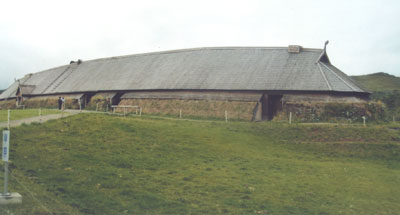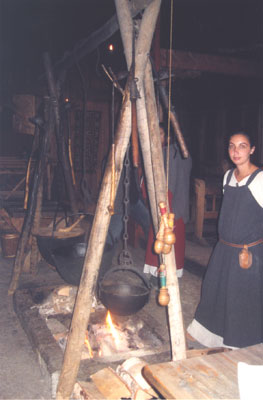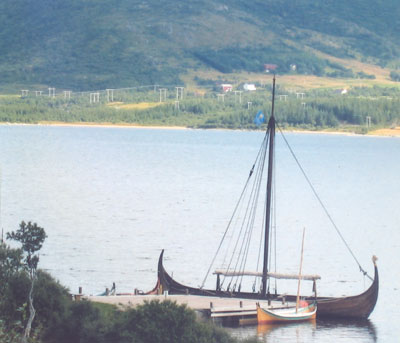Norway: A Viking chieftain’s home
This item appears on page 67 of the February 2011 issue.
Around the year AD 500, long before the Viking era began in the second half of the eighth century, a chieftain on the island of Vestvågøy, in Norway’s Lofoten Islands above the Arctic Circle, built himself a house worthy of his status.
It was an enormous longhouse, 221 feet long, with turf walls and (probably) a wood-shingled roof. It stood on a hill with a sweeping view over the countryside. It could be seen from a distance, which is one of the reasons it was built where it was. It was meant to awe and impress visitors as they approached.
The longhouse survived four centuries and, at some point, was expanded to 274 feet. No one knows the names of the chieftains who lived there near the present-day hamlet of Borg, although it is fairly certain that the last chieftain to dwell there was Olaf Tvennumbruni, who picked himself up and left, with his followers, around AD 900. He relocated to Iceland probably because of disputes with neighboring fellow chieftains.
There followed a thousand-year hiatus until 1981, when a farmer noticed that the earth was darker where he ploughed. This led to archaeological excavations which revealed the floor plan of the long-abandoned longhouse.
Visitors to Borg can see the exact location of the original longhouse. A guide, dressed as a Viking of 1,200 years ago, points out the markers in the ground where posts bearing the weight of the roof once stood.
Perfect replica
An exercise of the imagination is not required as it is at many archaeological sites, since there at Borg a full-scale replica has been constructed adjacent to the original longhouse site.
Inside, the longhouse is three-aisled, with pairs of wooden posts supporting a 30-foot-high, steeply pitched roof.
There are five distinct sections inside: a foyer situated between the living quarters and the Great Hall, a storeroom for grain, and a barn large enough to shelter 40 to 50 cows.
The living quarters are furnished to look the way they might have in the year AD 800, with wooden tables for household chores and handicrafts. The Great Hall has long wooden tables and benches where the chieftain’s retinue would have dined. The chieftain and his lady would have sat at the head of the hall at an elevated table. Both the living quarters and the Great Hall have central hearths for cooking and for warmth.
Guides demonstrate the various activities that might have taken place in the longhouse. They make it come alive, especially when visitors are invited to take turns donning a Viking helmet and cloak and seating themselves at the Great Hall’s high table.
More to see
The museum grounds at Borg are extensive. Visitors can walk past numerous Iron Age (500 BC-AD 500) burial mounds to the bay where a replica of the ninth-century Viking ship Gokstad (Dec. ’10, pg. 60) lies at anchor. You can climb aboard the ship to explore. Nearby is a reconstructed Viking-era boathouse and a working smithy whose forge has an enormous bellows.
My husband, Paul, and I consider the Lofoten Islands one of the most beautiful places on Earth. It’s why we’ve traveled there three times in the past eight years.
The Lofotens are a chain of jagged mountains off Norway’s rugged western coast. Tiny villages lie at the foot of these mountains beside the sea. Sheep graze on the steep mountainsides and along the uncrowded roads.
When we last visited, in mid August 2009, we had missed the midnight sun — from late May to mid July the sun never sinks below the horizon — but there were still vivid lingering sunsets until almost midnight. It’s idyllic and peaceful, our piece of heaven on earth.
If you go. . .
The Lofotr Viking Museum at Borg, or Lofotr - Vikingmuseet på Borg (Prestegårdsveien 59, N-8360 Bøstad, Norway; phone 76 08 49 00, fax 49 10), is open from 10 to 7 daily from early June to mid August. Hours are shorter the rest of the year. The admission charge is 100 kroner, about $17.
We flew SAS (as we always do on trips to Scandinavia) from Newark to Oslo via Copenhagen, then on to Bodø in northern Norway and finally to Leknes in the Lofoten Islands. This last, short, 25-minute segment was aboard the airline Widerøe, part of the SAS Group (800/221-2350).
Visit Norway is excellent website to check for information on Norway (including the Lofotr Viking Museum at Borg).
If you have never stayed in a rorbu, a Norwegian fisherman’s cottage, take the opportunity to do so while visiting the Lofotens. Rorbuer are simply furnished cottages with combination living/dining room/kitchen, bathroom and one or more bedrooms.
Our favorite rorbuer are in the villages of Storvågen, Henningsvaer , Mortsund, Nusfjord and Å i Lofoten. Prices generally run about $150 to $200 per night, although some rorbuer can cost much more, depending on view and size.
Villa Lofoten
On our trip to the Lofoten Islands, however, we spent two weeks in a vacation villa wedged between the sea and the mountains in the hamlet (population 30) of Kvalnes on the island of Vestvågøy, about a half-hour drive from the Leknes airport (and a 15-minute drive from the Viking Museum at Borg).
The location was spectacular, with views in all directions. The house was special as well and had been featured in a Norwegian House & Garden-type magazine.
It had a kitchen/dining room, two living rooms, a library loaded with books, and three bedrooms furnished in an upscale country rustic Norwegian style. The bathroom had floor-to-ceiling windows overlooking a red barn, the sea and the mountains beyond. There was a lovely garden and even a private rock-strewn beach (too cold for swimming) a five-minute walk from the house.
The cost in season was 13,000 Norwegian kroner (about $2,167) per week. The cost out of season was 9,000 kroner ($1,500) per week. Prices are lower per week if you stay longer, as we did. We paid $2,833 for a two-week rental (about $202 per day) for a mid-to-late-August rental — a bargain, we thought, for what we got.



